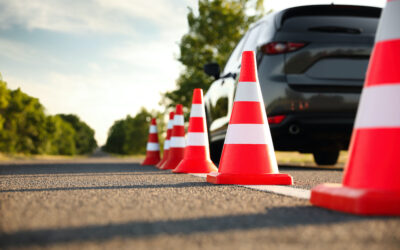The gears in a car are one of the hardest things for learner drivers to get to grips with. What are they for, and how are you supposed to know when to change up or down?
Your instructor will talk you through how gears work, how to change them, and how to tell when it’s time to change them. Some cars even have displays on the dashboard advising you on gear changes. You’ll often get a little arrow pointing up when it’s time to shift up, and a little arrow pointing down when it’s time to drop a gear.
But eventually, you won’t need any of this. No matter how hard it might seem now, eventually gear changes will become second nature to you. You’ll find yourself changing gears even before you think about changing gears!
Yet it will take you a while to get to that point. And before you get there, it pays to understand what each gear is for, and when you might use it.
How do Car Gears Work?
The gears in the car are for transmitting power from your engine to your wheels. To put it as simply as possible, low gears are for travelling at low speeds, and high gears are for travelling at high speeds.
How to Tell you’re in the Wrong Gear?
You’ll be able to tell when you’re in the wrong gear. If you travel too fast in a low gear, you’ll be able to hear and feel the strain from the engine. Similarly, if you travel too slow in a high gear, your car may start to judder. It may even stall.
Manual cars will either have five gears or six, as well as the gear for reverse. Let’s take a look at each gear in turn – what it’s for, and when you might use it.
Please note that these are general guidelines. Any speed we quote will not necessarily apply to every car.
When to Use First Gear
Most journeys start in first gear. You’ll use first gear to get your car moving, only switching to second when you reach a speed between 6 mph and 10 mph.
Most journeys end in first gear, too. You’ll drop back to first gear when you need a level of control you can rely on, such as when you’re manoeuvring into a parking space.
First gear is also essential for driving up steep hills. Using low gears makes your engine generate more force, which will give you more power for climbing up hills.
When to Use Second Gear
This is for driving at slow speeds, or in situations where power and control is more important than speed. When moving through the gears as you pick up speed, second gear is generally good for speeds of up to 20 mph.
You’ll find yourself using second gear as you travel through tight suburban streets, and as you cruise a car park looking for a space. And like first gear, second gear is also essential for driving up hills.
It’s generally good practice to drop to a lower gear when you’re travelling downhill too. Engine braking is more effective in lower gears, so you’ll have more control over the car.
When to Use Third Gear
Good for speeds of up to 30 mph. While second gear is generally good for speeds of up to 20 mph, in some cars you may feel a strain if you try and drive in second gear past 16 mph or so. In such cases, third gear is a lot more comfortable and a lot more efficient.
So think of third gear as the gear you’d use when you need to travel slow, yet not too slow.
When to Use Fourth Gear
When you’re not driving on motorways or carrying out manoeuvres, you’ll probably do most of your driving in fourth gear. Fourth gear is best for speeds between 30 mph and 40 mph. So it’s good for city driving, for a lot of country driving, and for picking up speed as you join a motorway.
When to Use Fifth Gear
This is for when you have the need for speed – on motorways, dual carriageways, and so on. It’s good for speeds above 40 mph, and for occasions when you no longer intend to increase the speed of your car.
When to Use Sixth Gear
Not all cars have sixth gear. But in those that do, fifth gear is just another step as you pick up speed and move through the gears. In these cars, you’d use fifth gear at speeds between 40 mph and 50 mph, only moving to sixth gear when you want to go faster.
When to Use Reverse
For travelling backwards! The reverse gear will usually generate the same level of power you’d get from first gear. This means that you won’t be able to travel very fast in reverse. But then, you wouldn’t want to travel very fast, or very far, in reverse anyway!
How to Know When to Change Up or Down Gears
All the recommended speeds are just guidelines. You’ll know when it’s time to move up a gear, as you’ll start to hear and feel a strain from the engine. If you need to move down you might feel your car pulling you forward on the flat, struggling to get up a hill or even start juddering.
Just remember the general rule of thumb that the slower you’re travelling, the lower the gear you’ll need to use. If your car starts juddering, or you stall, then you’re probably in too high a gear!
Similarly, if you find yourself struggling to make it up a hill, then you know it’s time to drop a gear.
How to Change Gears in a Car
Changing gears in a car all starts with the clutch.
You can learn more about what the clutch is, and how it works, in our guide to clutch control, and in our guide to avoiding stalling your car.
Your driving instructor will probably teach you to use the clutch before they teach you anything else, as it’s crucial to many aspects of driving.
Here’s the four steps you’ll need to follow whenever changing gears – whether it’s moving from first to second gear, fourth to fifth gear, or down again:
- Put your clutch down. Take the pressure off the accelerate pedal.
- Move your gearstick from the gear you’re currently in to the gear you need.
- Gradually bring the clutch up – but not all the way up, and not so fast! Bring your clutch up too quickly and you’ll stall.
- Apply a little bit of pressure to the accelerator, and at the same time, bring the clutch fully up and remove your foot from the pedal.
That’s it! It’s a bit of a balancing act between the accelerator and the clutch. It will take you some time to get used to it. But you will get used to it. And once you do, you’ll wonder how you ever found it so challenging.
Some cars require you to pull the gearstick up a little, or push it down a little, before you shift into reverse. This is to prevent you from entering reverse gear by accident.
Completely New to Driving?
Learning to drive can be a challenge. It can be unnerving and often frustrating. But it can also be incredibly exciting and, ultimately, extremely rewarding.
We have a comprehensive guide to learning to drive, which links to numerous additional resources to help you with every step of your journey.
If you want to pass your test first time, it helps to get some extra practice outside of your driving lessons. Head here for our complete guide to private driving practice for learners.
You’ll have to sort out your own insurance for these sessions. At Go Girl, we specialise in giving learner drivers full cover for less.
Get in touch for a free quote in minutes.




